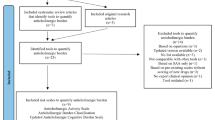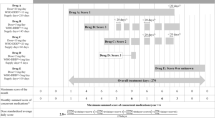Abstract
Background
Older people are exposed to multiple medicines that possess anticholinergic properties. The use of anticholinergic medicines is associated with the risk of morbidity, mortality and cognitive decline, particularly in older people. Anticholinergic exposure can be measured using tools such as the Drug Burden Index-Anticholinergic component (DBI-ACh) and the Anticholinergic Drug Scale (ADS).
Objective
The aim of this population-level study was to determine the extent of anticholinergic exposure in older people, particularly among those receiving acetylcholinesterase inhibitors in New Zealand.
Methods
The study used data extracted from Pharmaceutical Claims Data Mart (Pharms) for the year 2011. A total of 537,387 individuals aged 65 years and older were included in the study, of whom 45.10 % were men. Individuals dispensed donepezil at any time during 2011 were selected as the acetylcholinesterase inhibitor (AChEI) group (n = 4,258) and the remainder were included in the non-acetylcholinesterase inhibitor (non-AChEI) group (n = 533,129). Anticholinergic exposure was measured using the DBI-ACh and the ADS.
Results
Analysis of the Pharms dataset revealed that, in 2011, anticholinergic exposure as defined by the DBI-ACh and the ADS was 31.80 % and 52.66 %, respectively. The mean number of medicines dispensed was 5.64 ± 3.91 (±SD) with a 95 % confidence interval of 5.63–5.65. In the AChEI group, anticholinergic exposure using the DBI-ACh and the ADS was 42.93 % (median 0; interquartile range (IQR) 1) and 58.50 % (median 0; IQR 0), respectively. ADS level 3 medicines such as amitriptyline, nortriptyline and oxybutynin were commonly prescribed in both groups. Amitriptyline, nortriptyline, oxybutynin and paroxetine are medicines considered to have significant anticholinergic potency. Of these medicines, nortriptyline and oxybutynin were more frequently prescribed in individuals taking donepezil.
Conclusions
A significant proportion of older people are exposed to medicines with anticholinergic properties, including those dispensed acetylcholinesterase inhibitors. Further research is required to explore associations between different measures of anticholinergic exposure and clinically relevant outcomes in older people on a population level.


Similar content being viewed by others
References
Chew ML, Mulsant BH, Pollock BG, et al. Anticholinergic activity of 107 medications commonly used by older adults. J Am Geriatr Soc. 2008;56:1333–41.
De Wilde S, Carey IM, Harris T, et al. Trends in potentially inappropriate prescribing amongst older UK primary care patients. Pharmacoepidemiol Drug Saf. 2007;16:658–67.
Peters NL. Snipping the thread of life: antimuscarinic side effects of medications in the elderly. Arch Intern Med. 1989;149:2414–20.
Williamson J, Chopin JM. Adverse reactions to prescribed drugs in the elderly: a multicentre investigation. Age Ageing. 1980;9:73–80.
Campbell N, Perkins A, Hui S, Khan B, Boustani M. Association between prescribing of anticholinergic medications and incident delirium: a cohort study. J Am Geriatr Soc. 2011;59(Suppl. 2):S277–81.
Wawruch M, Macugova A, Kostkova L, et al. The use of medications with anticholinergic properties and risk factors for their use in hospitalised elderly patients. Pharmacoepidemiol Drug Saf. 2012;21:170–6.
Feinberg M. The problems of anticholinergic adverse effects in older patients. Drugs Aging. 1993;3:335–48.
Remillard AJ. A pharmacoepidemiological evaluation of anticholinergic prescribing patterns in the elderly. Pharmacoepidemiol Drug Saf. 1996;5:155–64.
Moore AR, O’Keeffe ST. Drug-induced cognitive impairment in the elderly. Drugs Aging. 1999;15:15–28.
Sunderland T, Tariot PN, Cohen RM, Weingartner H, Mueller EA 3rd, Murphy DL. Anticholinergic sensitivity in patients with dementia of the Alzheimer type and age-matched controls: a dose-response study. Arch Gen Psychiatry. 1987;44:418–26.
Sunderland T, Tariot PN, Newhouse PA. Differential responsivity of mood, behavior, and cognition to cholinergic agents in elderly neuropsychiatric populations. Brain Res. 1988;472:371–89.
Cai X, Campbell N, Khan B, et al. Long-term anticholinergic use and the aging brain. Alzheimers Dement. 2012;9:377–85
Carriere I, Fourrier-Reglat A, Dartigues JF, et al. Drugs with anticholinergic properties, cognitive decline, and dementia in an elderly general population: the 3-city study. Arch Intern Med. 2009;169:1317–24.
Tune LE, Egeli S. Acetylcholine and delirium. Dement Geriatr Cogn Disord. 1999;10:342–4.
Landi F, Russo A, Liperoti R, et al. Anticholinergic drugs and physical function among frail elderly population. Clin Pharmacol Ther. 2007;81:235–41.
Lechevallier-Michel N, Molimard M, Dartigues JF, Fabrigoule C, Fourrier-Reglat A. Drugs with anticholinergic properties and cognitive performance in the elderly: results from the PAQUID Study. Br J Clin Pharmacol. 2005;59:143–51.
Wagg AS. Antimuscarinic treatment in overactive bladder: special considerations in elderly patients. Drugs Aging. 2012;29:539–48.
Mulsant BH, Pollock BG, Kirshner M, Shen C, Dodge H, Ganguli M. Serum anticholinergic activity in a community-based sample of older adults: relationship with cognitive performance. Arch Gen Psychiatry. 2003;60:198–203.
Hilmer SN, Mager DE, Simonsick EM, et al. A drug burden index to define the functional burden of medications in older people. Arch Intern Med. 2007;167:781–7.
Hanlon JT, Schmader KE, Boult C, et al. Use of inappropriate prescription drugs by older people. J Am Geriatr Soc. 2002;50:26–34.
Lowry E, Woodman RJ, Soiza RL, Hilmer SN, Mangoni AA. Drug burden index, physical function, and adverse outcomes in older hospitalized patients. J Clin Pharmacol. 2012;52:1584–91.
Pasina L, Djade CD, Lucca U, et al. Association of anticholinergic burden with cognitive and functional status in a cohort of hospitalized elderly: comparison of the Anticholinergic Cognitive Burden Scale and Anticholinergic Risk Scale: results from the REPOSI Study. Drugs Aging. 2013;2:103–112
Campbell N, Boustani M, Limbil T, et al. The cognitive impact of anticholinergics: a clinical review. Clin Interv Aging. 2009;4:225–33.
Wilson NM, Hilmer SN, March LM, et al. Associations between drug burden index and mortality in older people in residential aged care facilities. Drugs Aging. 2012;29:157–65.
Mangoni AA, van Munster BC, Woodman RJ, et al. Measures of anticholinergic drug exposure, serum anticholinergic activity, and all-cause postdischarge mortality in older hospitalized patients with hip fractures. Am J Geriatr Psychiatry. Epub 2012 May 28.
Gnjidic D, Bell JS, Hilmer SN, Lonnroos E, Sulkava R, Hartikainen S. Drug Burden Index associated with function in community-dwelling older people in Finland: a cross-sectional study. Ann Med. 2012;44:458–67.
Ancelin ML, Artero S, Portet F, Dupuy AM, Touchon J, Ritchie K. Non-degenerative mild cognitive impairment in elderly people and use of anticholinergic drugs: longitudinal cohort study. BMJ. 2006;332:455–9.
Rovner BW, David A, Lucas-Blaustein MJ, Conklin B, Filipp L, Tune L. Self-care capacity and anticholinergic drug levels in nursing home patients. Am J Psychiatry. 1988;145:107–9.
Flacker JM, Cummings V, Mach JR Jr, Bettin K, Kiely DK, Wei J. The association of serum anticholinergic activity with delirium in elderly medical patients. Am J Geriatr Psychiatry. 1998;6:31–41.
Han L, McCusker J, Cole M, Abrahamowicz M, Primeau F, Elie M. Use of medications with anticholinergic effect predicts clinical severity of delirium symptoms in older medical inpatients. Arch Intern Med. 2001;161:1099–105.
Montamat SC, Cusack BJ, Vestal RE. Management of drug therapy in the elderly. N Engl J Med. 1989;321:303–9.
Rochon PA, Gurwitz JH. Drug therapy. Lancet. 1995;346:32–6.
Koyama A, Steinman M, Ensrud K, et al. Ten-year trajectory of potentially inappropriate medications in very old women: importance of cognitive status. J Am Geriatr Soc. 2013;61: 258-63
Carnahan RM, Lund BC, Perry PJ, Pollock BG. A critical appraisal of the utility of the serum anticholinergic activity assay in research and clinical practice. Psychopharmacol Bull. 2002;36:24–39.
Rudolph JL, Salow MJ, Angelini MC, McGlinchey RE. The anticholinergic risk scale and anticholinergic adverse effects in older persons. Arch Intern Med. 2008;168:508–13.
Lampela P, Lavikainen P, Garcia-Horsman JA, et al. Anticholinergic drug use, serum anticholinergic activity, and adverse drug events among older people: a population-based study. Drugs Aging. 2013;30:321–30
Starr JM, Farrall AJ, Armitage P, McGurn B, Wardlaw J. Blood-brain barrier permeability in Alzheimer’s disease: a case-control MRI study. Psychiatry Res. 2009;171:232–41.
Farrall AJ, Wardlaw JM. Blood-brain barrier: ageing and microvascular disease: systematic review and meta-analysis. Neurobiol Aging. 2009;30:337–52.
Gnjidic D, Cumming RG, Le Couteur DG, et al. Drug Burden Index and physical function in older Australian men. Br J Clin Pharmacol. 2009;68:97–105.
Hilmer SN, Mager DE, Simonsick EM, et al. Drug burden index score and functional decline in older people. Am J Med. 2009; 122:1142–9.e1–2
Carnahan RM, Lund BC, Perry PJ, Pollock BG, Culp KR. The Anticholinergic Drug Scale as a measure of drug-related anticholinergic burden: associations with serum anticholinergic activity. J Clin Pharmacol. 2006;46:1481–6.
Statistics New Zealand. Demographic trends: 2011. Wellington: Statistics New Zealand, 2012 Jan 31. ISSN 1177-8075 (online) http://www.stats.govt.nz/browse_for_stats/population/estimates_and_projections/demographic-trends-2011.aspx. Accessed 10 Jan 2013.
Tune LE, Damlouji NF, Holland A, Gardner TJ, Folstein MF, Coyle JT. Association of postoperative delirium with raised serum levels of anticholinergic drugs. Lancet. 1981;2:651–3.
McCusker J, Cole M, Abrahamowicz M, Primeau F, Belzile E. Delirium predicts 12-month mortality. Arch Intern Med. 2002;162:457–63.
Murray AM, Levkoff SE, Wetle TT, et al. Acute delirium and functional decline in the hospitalized elderly patient. J Gerontol. 1993;48:M181–6.
Carnahan RM, Lund BC, Perry PJ, Chrischilles EA. The concurrent use of anticholinergics and cholinesterase inhibitors: rare event or common practice? J Am Geriatr Soc. 2004;52:2082–7.
Ness J, Hoth A, Barnett MJ, Shorr RI, Kaboli PJ. Anticholinergic medications in community-dwelling older veterans: prevalence of anticholinergic symptoms, symptom burden, and adverse drug events. Am J Geriatr Pharmacother. 2006;4:42–51.
Roe CM, Anderson MJ, Spivack B. Use of anticholinergic medications by older adults with dementia. J Am Geriatr Soc. 2002;50:836–42.
Modi A, Weiner M, Craig BA, Sands LP, Rosenman MB, Thomas J 3rd. Concomitant use of anticholinergics with acetylcholinesterase inhibitors in Medicaid recipients with dementia and residing in nursing homes. J Am Geriatr Soc. 2009;57:1238–44.
Tune LE. Anticholinergic effects of medication in elderly patients. J Clin Psychiatry. 2001;62(Suppl. 21):11–4.
Tune L, Carr S, Hoag E, Cooper T. Anticholinergic effects of drugs commonly prescribed for the elderly: potential means for assessing risk of delirium. Am J Psychiatry. 1992;149:1393–4.
Nishtala PS, Fois RA, McLachlan AJ, Bell JS, Kelly PJ, Chen TF. Anticholinergic activity of commonly prescribed medications and neuropsychiatric adverse events in older people. J Clin Pharmacol. 2009;49:1176–84.
Duran CE, Azermai M, Van der Stichele RH. Systematic review of anticholinergic risk scales in older adults. Eur J Clin Pharmacol. 2013;69:1485–96.
Davies P, Maloney AJ. Selective loss of central cholinergic neurons in Alzheimer’s disease. Lancet. 1976;2:1403.
Perry EK, Perry RH, Blessed G, Tomlinson BE. Necropsy evidence of central cholinergic deficits in senile dementia. Lancet. 1977;1:189.
Sims NR, Bowen DM, Allen SJ, et al. Presynaptic cholinergic dysfunction in patients with dementia. J Neurochem. 1983;40:503–9.
Robinson M, Rowett D, Leverton A, Mabbott V. Changes in utilisation of anticholinergic drugs after initiation of cholinesterase inhibitors. Pharmacoepidemiol Drug Saf. 2009;18:659–64.
Tsuno N, Homma A. What is the association between depression and Alzheimer’s disease? Exp Rev Neurother. 2009;9:1667–76.
Gill SS, Mamdani M, Naglie G, et al. A prescribing cascade involving cholinesterase inhibitors and anticholinergic drugs. Arch Intern Med. 2005;165:808–13.
Acknowledgements
The authors thank the Analytical Services, Ministry of Health of New Zealand for supplying the prescription data extracted from the Pharms database. The study was supported by the School of Pharmacy, Deans Contestable Fund, University of Otago. The authors have no conflicts of interest that are directly relevant to the content of the study.
Disclosure statement
The funding source had no involvement in the research process.
Author information
Authors and Affiliations
Corresponding author
Rights and permissions
About this article
Cite this article
Narayan, S.W., Hilmer, S.N., Horsburgh, S. et al. Anticholinergic Component of the Drug Burden Index and the Anticholinergic Drug Scale as Measures of Anticholinergic Exposure in Older People in New Zealand: A Population-Level Study. Drugs Aging 30, 927–934 (2013). https://doi.org/10.1007/s40266-013-0111-y
Published:
Issue Date:
DOI: https://doi.org/10.1007/s40266-013-0111-y




